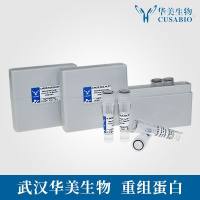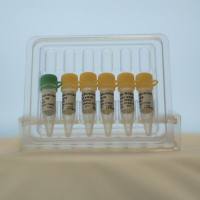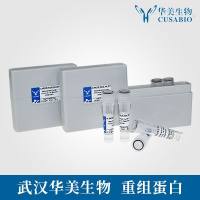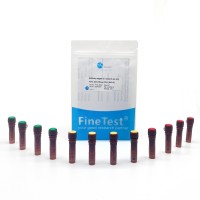Analysis of mRNA Populations from Single Live and Fixed Cells of the Central Nervous System
互联网
- Abstract
- Table of Contents
- Materials
- Figures
- Literature Cited
Abstract
This unit presents a method for the amplification of poly(A)+ mRNA extracted from the cytoplasm of a single cell. After cDNA is synthesized from the mRNA, it is made double stranded, denatured, and reverse transcribed to yield antisense RNA (aRNA). Another round of amplification results in a relatively large amount of aRNAs in essentially the same proportion as in the starting mRNA population. RNA amplification protocols can be used for many purposes, including generation of disease expression profiles, making of cDNA libraries, and generation of diagnostics and therapeutics for disease. An alternate protocol is used to amplify RNAs from single neurons in fixed tissue specimens. Support protocols gives instructions for reverse northern analysis, which allows analysis of the presence or absence and relative levels of mRNA expression in selected cells, and a convenient method to assess the RNA content in fixed tissue sections using the fluorescent dye acridine orange (which binds single?stranded nucleic acids).
Table of Contents
- Basic Protocol 1: Single‐Cell mRNA Amplification from Live Cells
- Alternate Protocol 1: Single‐Cell mRNA Amplification from Immunostained Fixed Cells
- Support Protocol 1: Reverse Northern Analysis of mRNA
- Support Protocol 2: Acridine Orange Labeling
- Reagents and Solutions
- Commentary
- Literature Cited
- Figures
- Tables
Materials
Basic Protocol 1: Single‐Cell mRNA Amplification from Live Cells
Materials
Alternate Protocol 1: Single‐Cell mRNA Amplification from Immunostained Fixed Cells
Support Protocol 1: Reverse Northern Analysis of mRNA
Materials
|
Figures
-
Figure 5.3.1 Schematic of mRNA harvesting from a single cell. A patch pipet is used to sample the cytoplasmic RNA from a single cell in dispersed cell cultures, slice cultures, or fixed tissue sections. View Image -
Figure 5.3.2 aRNA amplification schematic. The individual steps in the aRNA protocol are correlated with the molecular biology product resulting from the completion of each set of steps. View Image -
Figure 5.3.3 Nestin‐immunolabeled cortical section from patient with tuberous sclerosis and epilepsy. Numerous nestin‐labeled abnormal neurons are seen. Arrow points to space where single cell was microdissected and aspirated into a recording electrode. The RNA amplified from this single cell can be used as a probe in expression profiling or used as a source for PCR amplification of individual mRNA species, differential display of subpopulations of the mRNA, or to make cDNA libraries. Nestin antibody (AN129, diluted 1:1000 for these studies) was generously provided by Dr. J. Trojanowski, Univ. of Pennsylvania. View Image -
Figure 5.3.4 Reverse northern (slot) blot probed with 32 P‐labeled aRNA from a single immunolabeled human neuron. Brain specimens were obtained intraoperatively from a patient with tuberous sclerosis (an autosomal form of cerebral cortical dysplasia) and epilepsy. Brain samples were immersion‐fixed in 4% paraformaldehyde,embedded in paraffin, and cut at 7 µm. Sections were probed with anti‐nestin (human) antibodies. Blots were generated using linearized plasmid cDNAs as a target by binding these cDNAs to nylon membrane (Hybond), hybridizing with the aRNA probe, washing in SSC solutions containing 0.1% SDS, air drying, and apposing the probed membrane to film. The autoradiographic intensity of each hybridizing plasmid on the autoradiogram is a direct reflection of the amount of aRNA in the probe, which in turn reflects the amount of that particular mRNA in the original cell. A1, α3 subunit of the GABA‐A receptor; A2, microtubule‐associated protein 2 (MAP2); A3, α‐subunit of calcium/calmodulin kinase II; A4, α‐internexin (courtesy R. Liem); B1, connexin 26 (courtesy D. Paul); B2, connexin 32; B3, human nestin (courtesy U. Lendahl); B4, low molecular weight neurofilament (courtesy V. Lee); C1, GAP43; C2, high molecular weight neurofilament; C3, Ki67 (ATCC); C4, α2 subunit of the GABA A receptor; D1, pBluescript plasmid cDNA. View Image
Videos
Literature Cited
| Literature Cited | |
| Bargas, J., Howe, A., Eberwine, J., and Surmeier, J. 1994. Acutely isolated rat neostriatal neurons express four types of high‐voltage activated calcium currents. J. Neurosci. 14:6667‐6686. | |
| Cao, Y., Wilcox, K., Martin, C., Eberwine, J., and Dichter, M. 1996. Presence of mRNA for glutamic acid decarboxylase in both excitatory and inhibitory neurons: Implications for a new form of neuronal plasticity. Proc. Natl. Acad. Sci. U.S.A. 93:9844‐9849. | |
| Chee, M., Yang, R., Hubbell, E., Berno, A., Huang, X., Stern, D., Winkler, J., Lockhart, D., Morris, M., and Fodor, S. 1996. Accessing genetic information with high‐density DNA arrays. Science 274:610‐614. | |
| Crino, P. and Eberwine, J. 1996. Molecular characterization of the dendritic growth cone: Regulated mRNA transport and local protein synthesis. Neuron 17:1173‐1187. | |
| Crino, P., Dichter, M., Trojanowski, J., and Eberwine, J. 1996. Single cell molecular pathology: An analysis of tuberous sclerosis. Proc. Natl. Acad. Sci. U.S.A. 93:14152‐14157. | |
| Eberwine, J. 1996. Amplification of mRNA populations using aRNA generated from immobilized oligo‐dT‐T7 primed cDNA. BioTechniques 20:584‐586. | |
| Eberwine, J., Yeh, H., Miyashiro, K., Cao, Y., Nair, S., Finnell, R., Zettel, M., and Coleman, P. 1992. Analysis of gene expression in single live neurons. Proc. Natl. Acad. Sci. U.S.A. 89:3010‐3014. | |
| Eberwine, J., Crino, P., and Dichter, M. 1995. Single cell mRNA amplification: Basic science and clinical implications. Neuroscientist 1:200‐211. | |
| Finnell, R., VanWaes, M., Bennett, G., and Eberwine, J. 1993. Lack of concordance between heat shock proteins and the development of tolerance to teratogen induced neural tube defects. Dev. Genet. 14:137‐147. | |
| Lockhart, D., Dong, H., Byrne, M., Follettie, M., Gallo, M., Chee, M., Mittmann, M., Wang, C., Kobayashi, M., Horton, H., and Brown, E. 1996. Expression monitoring by hybridization to high‐density oligonucleotide arrays. Nature Biotech. 14:1675‐1680. | |
| Mackler, S. and Eberwine, J. 1993. Diversity of glutamate receptor subunit mRNA expression within live hippocampal CA1 neurons. Mol. Pharmacol. 44:308‐315. | |
| Mackler, S., Brooks, B., and Eberwine, J. 1992. Stimulus‐induced coordinate changes in mRNA abundance in single post‐synaptic hippocampal CA1 neurons. Neuron 9:539‐548. | |
| Miyashiro, K., Dichter, M., and Eberwine, J. 1994. On the nature and distribution of mRNAs in hippocampal neurites: Implications for neuronal functioning. Proc. Natl. Acad. Sci. U.S.A. 91:10800‐10804. | |
| Nair, S. and Eberwine, J. 1994. Molecular correlates of corticosterone action in hippocampal subregions. Neurobiology of steroids. In Methods in Neurosciences, Vol. 22 (P. Conn, series ed.) pp.314‐329. Academic Press, New York. | |
| Surmeier, J., Eberwine, J., Wilson, C., Cao, Y., Stefani, A., and Kitai, S. 1992. Cellular and molecular evidence for the co‐localization of dopamine receptor subtypes in acutely‐isolated rat striatonigral neurons. Proc. Natl. Acad. Sci. U.S.A. 89:10178‐10182. | |
| Tecott, L., Barchas, J., and Eberwine, J. 1988. In situ transcription: Specific synthesis of cDNA in fixed tissue sections. Science 240:1661‐1664. | |
| Topaloglu, H. and Sarnat, H. 1989. Acridine orange‐RNA fluorescence of maturing neurons in the perinatal rat brain. Anat. Rec. 224:88‐93. | |
| van Gelder, R., von Zastrow, M., Yool, A., Dement, W., Barchas, J., and Eberwine, J. 1990. Amplified RNA (aRNA) synthesized from limited quantities of heterogeneous cDNA. Proc. Natl. Acad. Sci. U.S.A. 87:1663‐1667. | |
| Zangger, I., Tecott, L., and Eberwine, J. 1989. In situ transcription: A methodological study using propiomelanocortin gene expression in the rat pituitary as a model. Technique 1:108‐117. |









